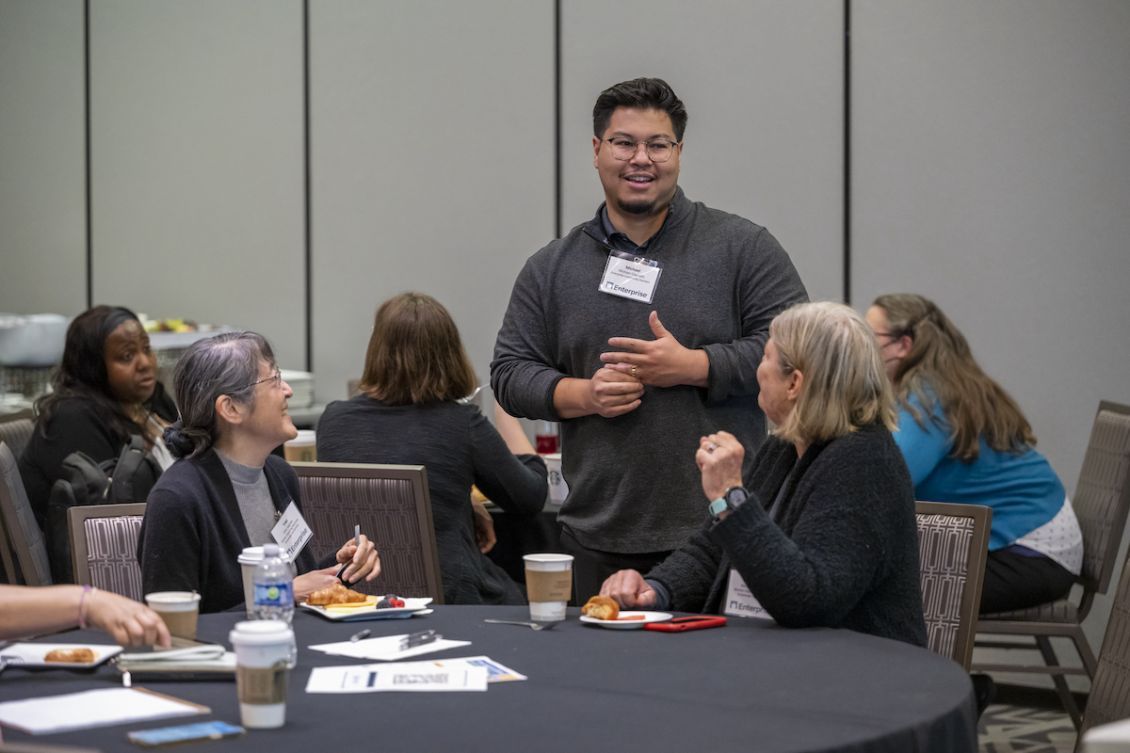“I really want to make the Sustainable Connected Communities program live at this intersection of affordable housing and climate resilience. To me, that is the sweet spot.”
That’s how Michael Claproth sums up his work leading Enterprise’s Sustainable Connected Communities (SCC) in Southern California. Before joining Enterprise two years ago as the SCC senior program director, Claproth worked on California Housing Partnership’s sustainable housing team, assisting in the program’s operations, technical assistance, and policy advocacy.
SCC’s goal is to ensure the program’s partners have all the tools to stabilize their buildings and portfolios. “We want to make their properties as viable as possible from financial and physical standpoints, and to make them resilient to our changing climate,” Claproth said.
In early 2022, Mariah Lima-Kuderer joined the team as a SCC fellow to assist in expanding the program’s reach.
Upfront Investment, Staff Bandwidth, and Insufficient Funding
It’s not an uncommon refrain within the affordable housing sector when dealing with any number of challenges: There is an overwhelming need for additional funding coupled with increased staff time and training. That’s certainly the case for housing providers preparing for an uncertain future with extreme weather events and the need to decarbonize homes to create greater energy efficiency and healthier communities.
Financing to build affordable homes is challenging, and it becomes even more difficult when trying to retrofit and decarbonize portfolios, Claproth said. While funding programs do exist, they are fraught with barriers.
“A lot of these programs are rebate programs. A developer will have to pay for the work upfront and then get the funding on the backend,” Claproth said. “If you are doing a full electrification retrofit, that’s potentially millions of dollars to pay for consultants, engineers, contractors in addition to the materials. Affordable housing providers are operating on thin margins and that’s just not feasible.”
Most housing provider staff members are focused on their job of getting people into homes and are not trained to oversee retrofit projects. “We cannot expect staff to know all the ins and outs of policy and technology, and it becomes a bandwidth issue to take advantage of existing programs.”
Completing the prerequisite paperwork is onerous for most housing providers. “It’s like putting another capital stack together, and it may not cover the full amount, which means the funding shortfall will have to come out of pocket.”
State, Local, and Federal Solutions
There are programs in the work that offer promising opportunities, Claproth said. The city of Los Angeles is working on equitable decarbonization policies that will prioritize affordable housing and the people who live in those buildings.
Funded by LA’s Department of Water and Power, the Los Angeles Better Building Challenge brought together a cross-sector of experts – including housing providers, commercial building owners, engineers, and decarbonization and retrofit experts – to streamline the process of accessing resources and to build the capacity of developers to make them more competitive in the electrification marketplace.
At the state level, the Affordable Housing and Sustainable Communities program has provided $3 billion to cross-sector teams of municipalities, developers, and community development organizations. Since its inception, the program has contributed to the development of 17,000 affordable homes and thousands of transportation improvement projects, reducing greenhouse gas emissions by 5 million metric tons.
At the federal level, the Inflation Reduction Act brings much-needed funding. Billions of dollars will assist in paying for retrofits and building developers’ capacity.
A Shining Example: Retrofit.LA
Retrofit.LA is a program that helps put all the pieces of the puzzle together for housing providers who want to upgrade their properties. “They talked directly with developers to explore their needs and then built this program to provide solutions,” Claproth said. “They created a one-stop shop for electrification projects.”
Retrofit.LA provides a full spectrum of needed resources, from identifying funding sources to contractor selection to case studies and evaluations of completed projects. Most importantly, they provided one-on-one guidance during the entire process.
“Each project is very different and nuanced, and you need experts to help you through the entire process,” Claproth said.
Mission-Driven Inspiration
Claproth got his mission-driven inspiration from his mother, Yolanda Arias Claproth, an attorney for the Legal Aid Foundation of Los Angeles. “She grew up in East LA, and after she earned her law degree, she returned to East LA to focus on public service.”
He and his brothers would go to the legal aid office with her, and through that experience, they learned the importance of being rooted in the community.
“The way I got to my housing and climate focus was by chance. While in college, I was interested in transportation, electoral politics, and climate and housing policy,” Claproth said. “Through fellowships and jobs, it started to home in on me: Our intense homelessness challenge in Los Angeles is a housing supply problem. It’s compounded by the fact of a worsening climate and dealing with increased weather events.
“I was lucky to find a job that could address these issues at the same time.”
